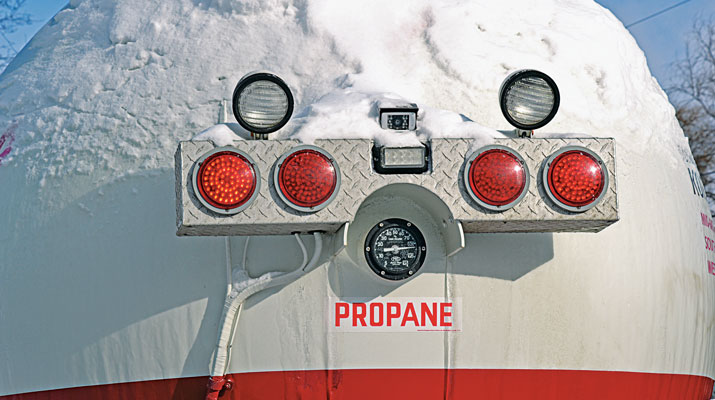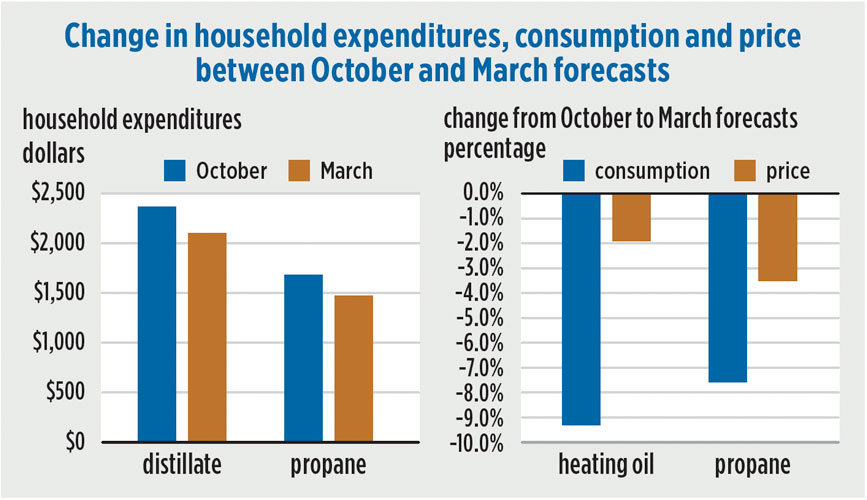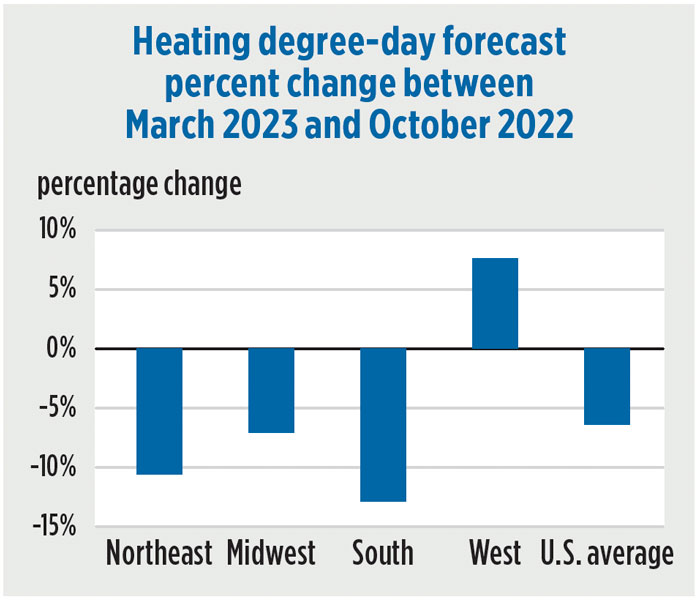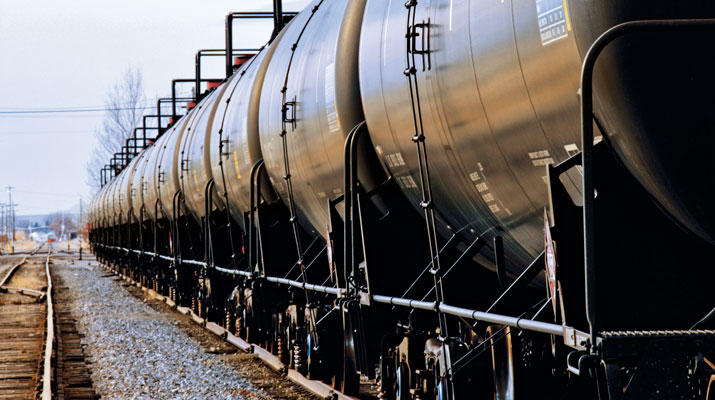Smoother deliveries, suitable supply characterize 2022-23 winter

The propane industry made it through the winter heating season relatively unscathed. (Photo by LP Gas staff)
Although the arrival of a brutal New England nor’easter can quickly alter the consensus, as of St. Patrick’s Day, this past heating season was being widely viewed as relatively smooth and manageable, with any localized bottlenecks competently addressed and remedied.
While this success is attributed by some to a wee bit of luck o’ the Irish, others are celebrating the industry’s embrace and adaptation of the advance-planning strategies that have been pushed for years by industry leaders encouraging increased training and education.
However, the pre-winter planning doesn’t prevent all obstacles from forming. A lot can happen from October through March.
Fire and ice challenged California propane marketers, as the aftermath of recent wildfires presented logistical detours. The state was beset additionally by uncharacteristically severe rainfalls, snowfalls and ice storms. The rain, snow and ice caused significant flooding throughout the winter, especially in the more mountainous areas where residents burned higher-than-normal levels of propane.
Several regions experienced lifestyle-impacting power outages lasting a week to 10 days, emphasizing the value of having an LPG-powered electrical generator at the ready.
“A lot of people have been running their propane generators at higher loads and longer times,” reports Colin Sueyres, president and CEO of the Western Propane Gas Association.
Unusually heavy icing and snowfalls closed roads and rendered numerous customer driveways inaccessible. States implemented hours-of-service (HOS) exemptions as propane marketers put in the maximum allowable efforts to complete their deliveries.
Considering the hazardous road conditions, “we’ve been driving a little bit slower and putting chains on the back tires,” Sueyres says.

Less consumption in addition to declining fuel prices reduced EIA’s forecast expenditures for propane and heating oil. Data Source: U.S. Energy Information Administration, Winter Fuels Outlook, Short-Term Energy Outlook, October 2022 and Winter Fuels Outlook Update, March 2023. Note: Propane data is calculated using the weighted average of households in the Northeast, Midwest and South.
By mid-March, about a dozen major storms had been reported, bringing record-setting levels of rain and snow. Snowfall averaged 120 percent to 130 percent above normal. In January, California’s average snowpack hit 200 percent above normal, amounting to depths never seen by many residents.
The Golden State’s office of emergency services organized a daily conference call to coordinate the actions of first responders, utility executives – including propane retailers – and other key officials “to get everyone on the same page,” says Sueyres.
“This is a unique circumstance,” he observes. “This is rare.”
“Last-mile deliveries,” the portion of a route that involves getting into the driveway, were particularly problematic.
In some situations, roadways were completely impassible, and propane tanks were buried in the snow.
“It’s been crazy,” says Ray Galan, vice president of retail sales at Ferrellgas, who lives in California. “We’re bringing in people from other parts of the country” to assist in keeping the propane flowing, he notes, adding that the company was not close to experiencing similar problems elsewhere in the nation.
California’s propane supply was quite tight in December, but shortfalls eased considerably as the winter heating season progressed.
Generating sales
“Supply has been good in Minnesota,” says Dave Wager, executive director of the Minnesota Propane Association. “It hasn’t been tremendously cold, but we’ve struggled with deep snow and icy roads.”
The fall crop drying season was less robust than usual, thus it didn’t pull inventories down to previously recorded levels, says Wager. Snow blocked roads and driveways, but that’s not uncommon in Minnesota. “We’re used to that,” he observes. “It just slows down the process.”
In the Lone Star State, “we’ve had a good winter, but not epic as far as the weather goes,” says Bill Van Hoy, executive director of the Texas Propane Gas Association.
A noteworthy ice storm generated a widespread, weeklong power outage, and Van Hoy points out that propane retailers coped quite well with any of the related challenges, enjoying increased sales. “You’re going to sell more gas when there’s an ice storm.”
Along with inconvenienced homeowners, business owners in Texas were negatively impacted by the power outage – with some LPG marketers lacking a propane-powered in-house electrical generator for their own use.
“It made it difficult for those who didn’t have backup generation at their offices,” says Van Hoy.

The primary driver of decreased consumption is warmer weather than forecast in October. Data Source: U.S. Energy Information Administration, Short-Term Energy Outlook, based on forecasts by the National Oceanic and Atmospheric Administration
An area causing considerable concern for Van Hoy and his membership is an accelerated pace of new, tougher trucking regulations directed at drivers.
The state rules go beyond the standard government regulations. Such requirements, he says, are making it exceptionally difficult to recruit new hires, who are unwilling to achieve compliance, which in turn drives up the cost of doing business.
“That’s crippling for these guys who are trying to find drivers,” says Van Hoy.
Maintaining adequate propane stocks has been routinely accomplished in accordance with longstanding business practices, he says.
“Most marketers – even new marketers – are pretty well-versed in maintaining supply and having vendors available that they deal with,” Van Hoy explains, noting that such topics are frequently discussed at association meetings.
“I attribute that to good planning,” he says. “Every marketer takes that into account. They have that figured out.”
PADDs 4 and 5 in the Rockies and along the West Coast, respectively, had supply shortages in the fall that became less tight as winter carried forth. A rail-car shortage originating in Canada was complicated by railroad workers threatening to strike. A government decree, however, ended the threat in time for the U.S. to obtain its necessary domestic stock of tankers.
“It would have been a lot worse if Congress didn’t force the railroads to get back to work,” says DD Alexander, chair of the Propane Supply & Logistics Committee at the National Propane Gas Association (NPGA).

The winter heating season could have looked differently had railroad workers proceeded with a strike. Congress approved legislation late in 2022 to keep them on the job. (Photo: Brian Brown/iStock / Getty Images Plus/Getty Images)
A welcome commodity
Propane exports were running high, but Alexander remained confident that domestic supplies were adequate to meet demand. She notes that retailers and wholesalers alike are rather nimble in “expecting the unexpected” and adjusting to market shifts.
“The industry does a wonderful job at that,” says Alexander, president of Colorado-based supplier Global Gas. “The industry does a great job of moving when we have to.”
The flow of propane is especially critical given the weaknesses apparent in the nation’s electrical grid – particularly in coastal regions. “The infrastructure is so maxed out” that power outages are a common consequence of winter weather, making propane a welcome commodity, according to Alexander.
In California and throughout the country, industry leaders say, propane-powered electrical generators are popular for homeowners and businesses. They are realizing how the units can maintain functionality and comfort of living among the inhabitants under the most trying and stressful of circumstances: No electricity.
LPG is taking the lead in taking the edge off this growing pattern of distressing power outages driven by the infrastructural weaknesses afflicting the nation’s electrical grid.
Propane marketers are perfectly positioned to sell, service and fuel a valued solution to the public’s increasing energy anxiety.
According to Generac spokesman Dave Racine, it’s important to obtain the proper training before discussing generators with customers. This can include everything from determining the gauge of the extension cord that customers plan to plug in and which appliances they plan to power, to meeting the requirements of the local building code, to analyzing the intricacies of hardwiring the equipment.
“To become an authorized dealer or installer, there’s some homework to be done,” he says.
Austin Wicker, manager of state affairs at NPGA, has his own testimonial to offer regarding propane’s power generation properties following a strong windstorm that buffeted his Kentucky home.
“Once the winds subsided, my entire neighborhood was without power for nearly four days. Fortunately, I had a dual propane/gas generator on standby. I hooked a propane tank to my generator, popped some extension cords in, and was able to power the essentials in my home,” he recounts on NPGA’s website.
















